An old yakushima saying:
“Ten days at sea, ten days in the village, and ten days in the mountains”
This famous saying relates to the lifestyle of people on Yakushima and their connection to nature past and present. Yakushima is blessed with the rich ocean’s bounty and wild edible plants, and they have been abundant year around from olden times. Having these local cuisines would be an once-in-a-lifetime experience. Some of the ingredients may be unusual and rare. Why not come and try our local cuisines.
|
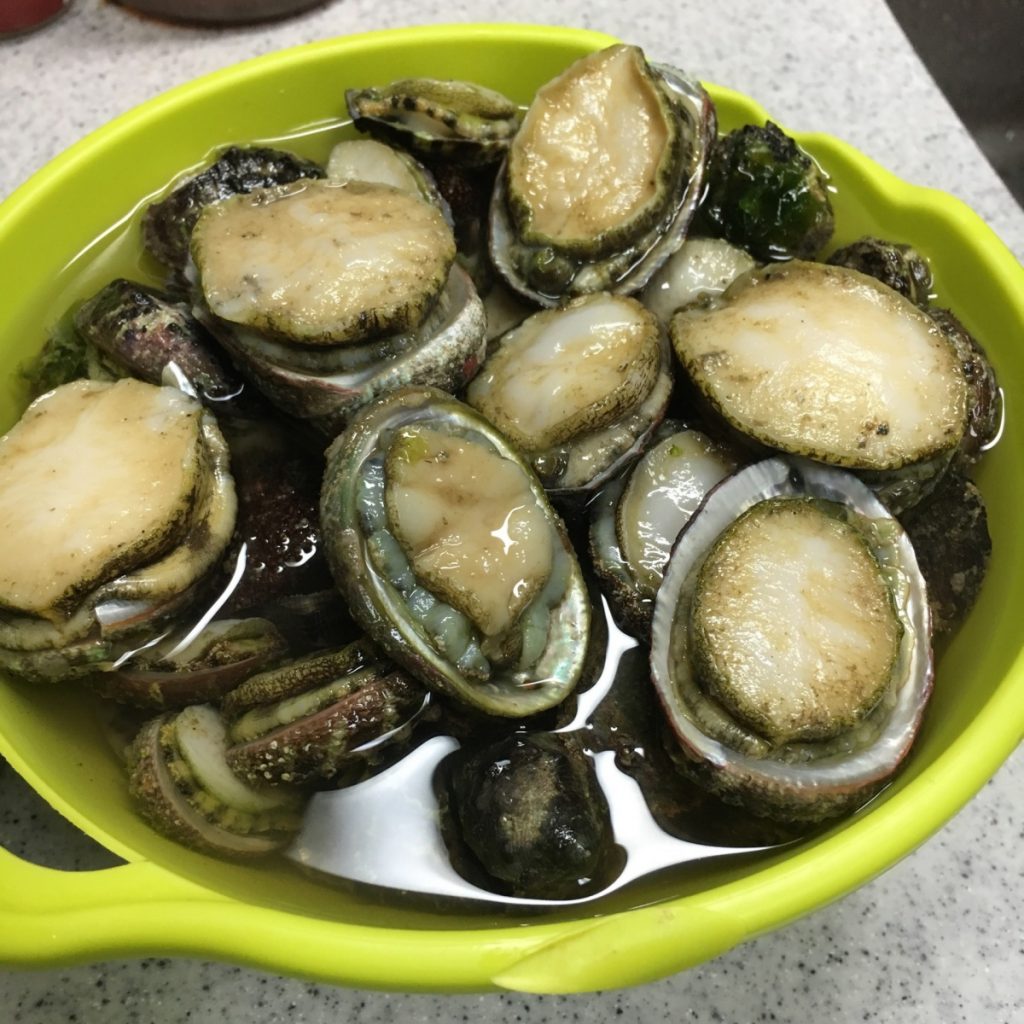
|
Saba (Mackerel)
Mackerel is one of the main fish caught in Yakushima. If you are lucky, you can enjoy raw mackerel sashimi. Mackerel quickly spoils and only a fleshy caught mackerel can be eaten raw. Please try another type of sashimi called ‘shime-saba’, vinegared mackerel, if you worry to eat raw sashimi. Another popular mackerel product is “Saba-bushi”. Saba-bushi is traditionally dried mackerel. Smoked Mackerel in a vacuum pack is also another popular product as a convenient snack or a side dish.
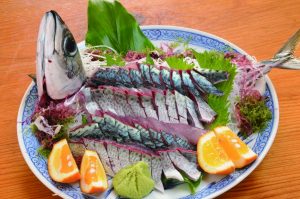
|
Kubiore-saba sashimi (Raw mackerel sashimi)
Mackerel is a fish for popular consumption in Japan; however, raw mackerel sashimi is one of a rare sashimi because it won’t keep long to eat as sashimi. Yakushima is famous for “Kubiore-saba”, specially prepared freshly caught mackerel. Having fresh mackerel in Yakushima is good opportunities for tourists, we highly recommend “Kubiore-saba”!
|
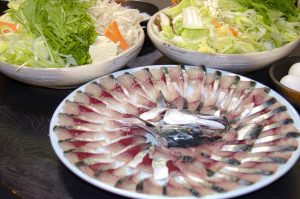
|
Saba-suki (Mackerel sukiyaki)
“Saba-suki” is one of Yakushima’s local cuisines. It is like sukiyaki but has mackerel instead of beef. It reminds us of ‘happy family dinners’. If you try it, you will fall in love with it.
|
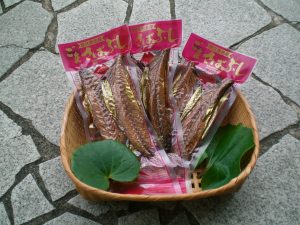
|
Saba-bushi (Dried mackerel)
Dried mackerels are made in Isso town, north part of Yakushima. It is said that soup stock made from dried mackerel is very good especially for Udon and Soba dishes. And dried mackerel is also an ingredient of choice for marinated foods and pickles. You can buy saba-bushi at tourist gift shops and at the local supermarkets. It is so good, that you will want to enjoy the taste and aroma again and again.
|
Tobiuo (Flying Fish)
Yakushima is known to have the largest catch of flying fish in Japan. You can see many different kinds of flying fish during the year at Anbo fishing port.
Not only deep-fried flying fish with its wings spread, but also raw fish “sashimi”, deep-fried minced fish patty “Tsukiage” and lightly sun dried flying fish are very popular. *Smoked flying fish have been getting popular.
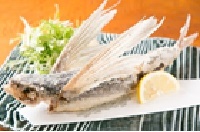
|
Toiuo kara-age (Deep-fried flying fish)
The figure of the flying fish with its wings (pectoral fins) spread out will amaze you. You can eat the entire fish including the wings, which are very crispy and tasty.
|

|
Tobiuo sashimi (Raw flying fish sashimi)
Tobiuo sashimi tastes light and delicate. It is served with sweet “Kyushu” soy sauce, which is loved by local people.
|
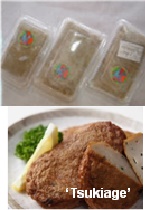
|
Tobiuo surimi (Minced flying fish)
Minced fish is one of the most popular home cooked food in Yakushima and with each household having their own recipe. In Yakushima flying fish is the main ingredient for this dish. There are several ways of cooking minced fish such as baked like a Hamburger, cooked in soup or in a traditional Japanese ‘nabe’ hot pot. But ‘Tsukiage’, deep-fried minced fish patties are a favorite home cooked dish in Yakushima.
|
Other Fish and Shellfish
|
Name & scientific name
|
Cooking methods
|
Image
|
|
‘Tokobushi’, small abalone
(scientific name: Sulculus diversicolor supertexta)
|
・‘Sashimi’
・‘Shio-yude’ (boiled with solt),
・‘Miso-zuke’ (pickled in miso paste)
|
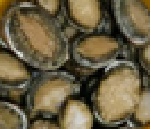
|
Many locals are looking forward to do ‘Isomon-tori’. When the spring tide has come, they go to collect these shellfish.
|
‘Kamente’ , Japanese goose barnacles
(scientific name: Capitulum mitella)
* ‘Kamente’ (literally means ‘the flippers of a turtle’) is so named because they resemble the turtle flippers. It is called ‘Percebes’ in Spain.
|
・‘Shio-yude’ (boiled with solt)
・Miso-soup
・good soup stock for noodles
☝ Many people may think that they are shellfish, but actually they belong to the Crustacea family same as crab and shrimp.
|
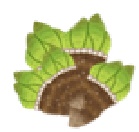
|
|
‘Jingasa&Yomegasa’ , (scientific name: callana nigrolineata)
|
・’Sashimi’
・‘Shio-yude’ (boiled with solt)
・Roast seasoned with soy sauce
・‘Miso-zuke’ (pickled in miso paste)
|
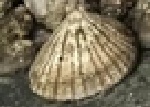
|
‘Kibinago, silver-stripe round herring
(scientific name: Spratelloides gracilis)
|
・’Sashimi’
・Miso-soup
・’Tempra’
・’Shio-yaki’ (salt-grilled)
|
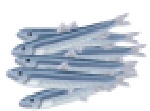
|
A shoal of kibinago fish you may see at a tide pool in spring.
|
Sansai (edible wild plants)
Yakushima receives the bounties of nature year round. Because of Yakushima’s abundant rain, rich soil, and environment, it is also known as a treasure house of plants. Many locals enjoy the harvesting of edible wild plants and are grateful for the natural blessing. If some edible wild plants are in season, you can also try them in some accommodations and/or restaurants. Why not try our nutritious wild edible plants which are so good for your health.
✿ ‘Tsuwa’ , Japanese silver elaf
(scientific name: Farrfugium japonicum)
|

|
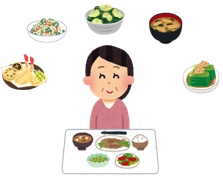
Popular home-style cooking of these wild plants for locals are ‘Tempra’, ‘Ohitashi’ (boiled and seasoned with soy sauce), ‘Shira-ae’ (boiled and dressed with ground tofu and sesame), ‘Miso-soup’, ‘Itamemono’ (stir-fries), ‘Sunomono’ (vinegared dish), etc.
|
✿ There are a variety of bamboos on Yakushima.
‘Madake’, ‘Kosan-dake’, and ‘Mouso-dake’, these bamboo shoots are edible.
|

|
|
✿ ‘Warabi’ (bracken)
|

|
|
✿ ‘Tara-no-me’ (young shoots of angelica tree)
|

|
|
✿ ‘Chomeiso’ (scientific name: Peucedanum japonicum)
|

|
|
✿ ’Yomogi’ (Japanese mugwort)
|
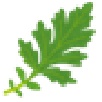
|
● Other vegetables (その他の野菜)
・里いも(Japanese taro) ・さつまいも(Sweet potato) ・ヤマイモ(Japanese yam)
・ラッキョウ(Shallots) ・春ウコン(Wild turmeric) ・秋ウコン(Turmeric) ・ガジュツ(Zedoary)
・しいたけ(Shiitake mushroom) etc.
Fruits
Many variety of fruits grow wild on Yakushima. Some of them are cultivated commercially, and some are native to the mountains. You may see them in the mountains by chance. Also some of them are made into sweets such as gelato, ice cream, juice, jam, jelly, cakes, and dried-fruits.
*Yakushima is the largest producer of “Tankan”. Kagoshima Prefecture has designated “Yakushima’s Tankan” as one of Kagoshima Prefecture’s Brand Product because of its size and quality.
|
Jan.
|
Feb.
|
Mar.
|
Apr.
|
May
|
Jun.
|
Jul.
|
Aug.
|
Sep.
|
Oct.
|
Nov.
|
Dec.
|
Harvest season/fruits
|
|
●
|
|
|
|
|
|
|
|
|
|
|
●
|
・ぽんかん(Ponkan)
|
|
|
●
|
●
|
|
|
|
|
|
|
|
|
|
・たんかん(Tankan)
|
|
|
|
|
|
●
|
●
|
●
|
|
|
|
|
|
・スモモ(Plum)
|
|
|
|
|
●
|
●
|
|
|
|
|
|
|
|
・ビワ(Loquat)
|
|
|
|
|
|
●
|
●
|
|
|
|
|
|
|
・野いちご Wild berries
|
|
|
|
|
|
|
●
|
●
|
|
|
|
|
|
・ヤマモモ(Bayberry)
|
|
|
|
|
|
|
|
●
|
●
|
|
|
|
|
・時計草(Passion fruit)
|
|
|
|
|
|
|
|
●
|
●
|
|
|
|
|
・マンゴー(Mango)
|
|
|
|
|
|
|
|
●
|
●
|
|
|
|
|
・パパイヤ(Papaya)
|
|
|
|
|
|
|
|
|
●
|
●
|
●
|
●
|
●
|
・ドラゴンフルーツ(Dragon fruits)
|
|
|
|
|
|
|
|
|
|
●
|
●
|
|
|
・グァバ(Guava)
|
|
|
|
|
|
|
|
|
|
|
|
|
|
・Shima Banana, wild banana
|
Local confections
There are several different types of traditional sweets on Yakushima. They are prepared as a special dish for a special day such as Children’s Day. The taste of them reminds us mother’s cook and child days.

|
‘Kakaran-dango’
|
A rice dumpling mixed with Japanese mugwort and sandwiched in between ‘Kakaran’ leaves
|

|
‘Tsunomaki’
|
A glutninous rice cake wrapped in ‘Dachiku’ leaf (giant reed leaf). It literally means ‘Horn roll” because it is wrapped in a triangular pyramid in shape and the corner of its looks like a horn
|

|
‘Akumaki’
|
It is cooked in the same way as ‘Tsunomaki’ but it is wrapped with bamboo skin to cylindrical shape
|



















